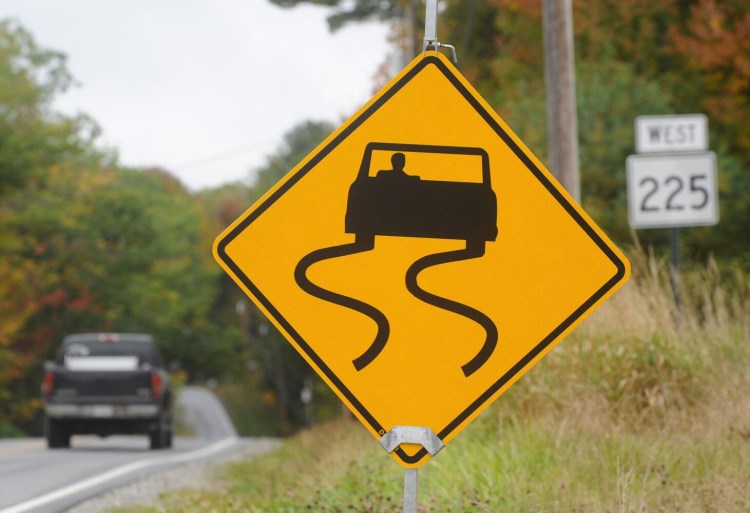The Maine Department of Transportation has decided to stop using a type of road sealant on the state’s travel lanes following an investigation of a near-deadly crash in Rome in which the slick surface was found to be a factor.
In October, the state agency temporarily halted the use of the product, called surface fog sealant, after a story in the Morning Sentinel spotlighted dangers associated with its use.
Fog sealant is a diluted asphalt that is sprayed onto roads to cost-effectively repair cracks and extend the life of pavement, according to the Maine DOT.
Paul Merrill, spokesman for the state DOT, likened the use of fog sealant to “putting icing on a moldy cake.”
“There are enough questions about its effectiveness and safety on travel lanes that we see no point in restarting the fog seal program,” Merrill said.
The material will continue to be used on shoulders, according to Merrill.
“People don’t drive on the shoulders,” he said. “The way that we treat a travel lane that sees potentially thousands of vehicles a day is different.”
A lot of roads, especially in rural parts of state, need more treatment,” Merrill said. “The bottom line is we just can’t afford to do that.”
A full rebuild of 1 mile of road can cost millions, and repaving could cost about $50,000, Merrill said, so applying sealant is a lower-cost way to shore up crumbling roads.
While investigating the issue in Rome, engineers from the Maine DOT found the process of applying fog sealant is “not as precise as we want it to be,” and that “a lot of the specifics of the application are left up to the discretion of the workers doing the fog sealing,” Merrill said.
“A lot of it is the manual change of a nozzle to increase the flow or decrease the flow,” he said. “There’s a lot of eyeballing to see if it’s being applied the right way.”

Tom Streznewski of Belgrade stands Oct. 2 near the section of Route 225 in Rome where his truck slid off the road in September and was destroyed.
In the Kennebec County town of Rome, Tom Streznewski’s truck lost traction in September on an area of Route 225 that had been treated recently with too much fog seal, creating a glassy surface. The truck rolled over and a tree punctured the back window, nearly killing the 58-year-old Belgrade resident.
Merrill confirmed that after the fog sealant was applied to that road in June, there had been four crashes in the area.
“One driver fell asleep, but the others were in the rain,” when the surface was especially slick, Merrill said.
In 2018, at least two crashes on Route 3 in Bar Harbor were attributed, in part, to the same sealant material, the Mount Desert Islander reported.
The state DOT has contracted out seven fog sealant projects across the state over the past five years, according to Merrill.
“Five of those projects involved older pavement,” Merrill said, “so the fog sealant did what it was supposed to do. The old pavement absorbed the sealant enough that it was effective.”
In Rome, as well as in Bar Harbor in 2018, the material was flagged as being “an issue.”
“We suspect overapplication,” Merrill said, “but it could have been any number of factors.”

Tom Streznewski of Belgrade walks Oct. 2 on Route 225 in Rome, where the pavement was ground to remove a sealant that he believes created a slick surface that caused his truck to slide off the road. Streznewski’s vehicle crashed Sept. 14 into the ditch at right and was destroyed.
The excessive sealant on the surfaces of Route 225 in Rome and Route 3 in Bar Harbor have since been removed.
“In Bar Harbor, there were a couple other things at play,” Merril said. “There were cooler temperatures when we applied that, the grade of the road was different and there were questions about over-application like there was in the Rome issue.
“It’s not exactly apples to apples, but we questioned the overapplication even though there were some other factors involved. Certainly with that incident and the one in Rome, there’s not a compelling reason to start up the fog seal program for travel lanes again.”
Going forward, Merrill said there are several other sealants the state can use to treat cracked pavement.
“Some roads may get shimmed, which means we fill in ruts or potholes,” Merrill said. “Some roads may get light surface treatments. It depends on the specifics of each given situation. As our funding issues persist, we aim to stretch every dollar we have as far as it will go to maintain safety and mobility.”
Comments are not available on this story.
Send questions/comments to the editors.


